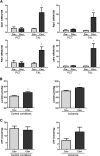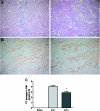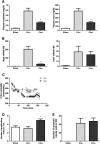Hypoxia-inducible transcription factors stabilization in the thick ascending limb protects against ischemic acute kidney injury
- PMID: 21921145
- PMCID: PMC3279994
- DOI: 10.1681/ASN.2010121249
Hypoxia-inducible transcription factors stabilization in the thick ascending limb protects against ischemic acute kidney injury
Abstract
Hypoxia-inducible transcription factors (HIF) protect cells against oxygen deprivation, and HIF stabilization before ischemia mitigates tissue injury. Because ischemic acute kidney injury (AKI) often involves the thick ascending limb (TAL), modulation of HIF in this segment may be protective. Here, we generated mice with targeted TAL deletion of the von Hippel-Lindau protein (Vhl), which mediates HIF degradation under normoxia, using Tamm-Horsfall protein (Thp)-driven Cre expression. These mice showed strong expression of HIF-1α in TALs but no changes in kidney morphology or function under control conditions. Deficiency of Vhl in the TAL markedly attenuated proximal tubular injury and preserved TAL function following ischemia-reperfusion, which may be partially a result of enhanced expression of glycolytic enzymes and lactate metabolism. These results highlight the importance of the thick ascending limb in the pathogenesis of AKI and suggest that pharmacologically targeting the HIF system may have potential to prevent and mitigate AKI.
Figures







Similar articles
-
The role of tumor necrosis factor alpha in regulating the expression of Tamm-Horsfall Protein (uromodulin) in thick ascending limbs during kidney injury.Am J Nephrol. 2014;40(5):458-67. doi: 10.1159/000369836. Epub 2014 Dec 6. Am J Nephrol. 2014. PMID: 25503683 Free PMC article.
-
p53 regulates renal expression of HIF-1{alpha} and pVHL under physiological conditions and after ischemia-reperfusion injury.Am J Physiol Renal Physiol. 2008 Dec;295(6):F1666-77. doi: 10.1152/ajprenal.90304.2008. Epub 2008 Sep 24. Am J Physiol Renal Physiol. 2008. PMID: 18815219 Free PMC article.
-
Tamm-Horsfall protein translocates to the basolateral domain of thick ascending limbs, interstitium, and circulation during recovery from acute kidney injury.Am J Physiol Renal Physiol. 2013 Apr 15;304(8):F1066-75. doi: 10.1152/ajprenal.00543.2012. Epub 2013 Feb 6. Am J Physiol Renal Physiol. 2013. PMID: 23389456 Free PMC article.
-
The VHL/HIF oxygen-sensing pathway and its relevance to kidney disease.Kidney Int. 2006 Apr;69(8):1302-7. doi: 10.1038/sj.ki.5000221. Kidney Int. 2006. PMID: 16531988 Review.
-
The VHL tumor suppressor: master regulator of HIF.Curr Pharm Des. 2009;15(33):3895-903. doi: 10.2174/138161209789649394. Curr Pharm Des. 2009. PMID: 19671042 Free PMC article. Review.
Cited by
-
Flexible and multifaceted: the plasticity of renin-expressing cells.Pflugers Arch. 2022 Aug;474(8):799-812. doi: 10.1007/s00424-022-02694-8. Epub 2022 May 5. Pflugers Arch. 2022. PMID: 35511367 Free PMC article. Review.
-
Role of Endothelial Prolyl-4-Hydroxylase Domain Protein/Hypoxia-Inducible Factor Axis in Acute Kidney Injury.Nephron. 2022;146(3):243-248. doi: 10.1159/000518632. Epub 2021 Sep 1. Nephron. 2022. PMID: 34515168 Free PMC article. Review.
-
Serum uromodulin-a marker of kidney function and renal parenchymal integrity.Nephrol Dial Transplant. 2018 Feb 1;33(2):284-295. doi: 10.1093/ndt/gfw422. Nephrol Dial Transplant. 2018. PMID: 28206617 Free PMC article.
-
Hypoxia: The Force that Drives Chronic Kidney Disease.Clin Med Res. 2016 Mar;14(1):15-39. doi: 10.3121/cmr.2015.1282. Epub 2016 Feb 4. Clin Med Res. 2016. PMID: 26847481 Free PMC article. Review.
-
Vhl deletion in renal epithelia causes HIF-1α-dependent, HIF-2α-independent angiogenesis and constitutive diuresis.Oncotarget. 2016 Sep 20;7(38):60971-60985. doi: 10.18632/oncotarget.11275. Oncotarget. 2016. PMID: 27528422 Free PMC article.
References
-
- Thakar CV, Christianson A, Freyberg R, Almenoff P, Render ML: Incidence and outcomes of acute kidney injury in intensive care units: A Veterans Administration study. Crit Care Med 37: 2552–2558, 2009 - PubMed
-
- Brezis M, Rosen S: Hypoxia of the renal medulla–its implications for disease. N Engl J Med 332: 647–655, 1995 - PubMed
-
- Eckardt KU, Bernhardt WM, Weidemann A, Warnecke C, Rosenberger C, Wiesener MS, Willam C: Role of hypoxia in the pathogenesis of renal disease. Kidney Int Suppl: S46–S51, 2005 - PubMed
-
- Heyman SN, Rosenberger C, Rosen S: Experimental ischemia-reperfusion: Biases and myths-the proximal vs. distal hypoxic tubular injury debate revisited. Kidney Int 77: 9–16, 2010 - PubMed
-
- Heyman SN, Shina A, Brezis M, Rosen S: Proximal tubular injury attenuates outer medullary hypoxic damage: studies in perfused rat kidneys. Exp Nephrol 10: 259–266, 2002 - PubMed
Publication types
MeSH terms
Substances
Grants and funding
LinkOut - more resources
Full Text Sources
Other Literature Sources
Molecular Biology Databases
Miscellaneous

